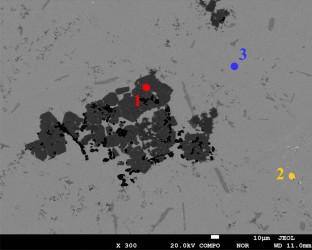Journal of Sustainable Metallurgy ( IF 2.4 ) Pub Date : 2022-04-05 , DOI: 10.1007/s40831-022-00506-y Baoqiang Xu 1, 2, 3 , Yifu Li 1, 2, 3 , Lingxin Kong 1, 2, 3 , Bin Yang 1, 2, 3 , Shuangping Wang 2, 3

|
The present research investigates the purification of crude tin by vacuum distillation. In this paper, the saturated vapor pressure of elements in crude tin was calculated, the activity coefficients of tin-based alloy at 1473 K were predicted by molecular interaction volume model, the separation coefficients (Pb, Bi, Sb, Zn, Cu, Fe) were calculated, and the Sn–Me (Pb, Bi, Sb, Zn) vapor–liquid equilibrium phase diagrams were established. The occurrence state of impurity elements in crude tin, vacuum distillation volatiles, and residues were detected by EPMA. The results show that the impurity element Pb in crude tin occurs in the form of small particles of Pb phase, Bi occurs in the Pb phase, As and Fe will form intermetallic compound AsFe, impurity elements Ni and Cu occur in the form of solid solution (Ni,Cu) or Ni–Cu–Fe–As, and Sb exists in the tin base. In the volatile, S, Zn, and Sn are present together in the areas close to the condenser, and As, Sn, Pb, and Sb are present in the areas far away from the condenser. Fe–As, Ni–Cu, and Ni–Fe phases exist in the residue. The equilibrium concentration and separation coefficient experiments show that when distillation time was extended to 150 min, the purity of tin in the residue increased from 91.55 to 96.18%; the impurity elements Pb, Bi, and Zn can be effectively removed; and the effective separation coefficients of As and Sb are far less than the calculated values.
Graphical Abstract
中文翻译:

粗锡真空蒸馏过程中杂质元素的去除及出现状况的调查
本研究探讨了真空蒸馏提纯粗锡的方法。本文计算了粗锡中元素的饱和蒸气压,采用分子相互作用体积模型预测了锡基合金在 1473 K 时的活度系数,分离系数(Pb、Bi、Sb、Zn、Cu、Fe ) 计算,建立了 Sn-Me (Pb, Bi, Sb, Zn) 气液平衡相图。EPMA检测粗锡中杂质元素、减压蒸馏挥发物、残留物的发生状况。结果表明,粗锡中的杂质元素Pb以小颗粒Pb相的形式存在,Bi以Pb相的形式存在,As和Fe会形成金属间化合物AsFe,杂质元素Ni和Cu以固溶体的形式存在(Ni,Cu) 或 Ni-Cu-Fe-As, Sb 存在于锡基中。在挥发物中,S、Zn、Sn一起存在于靠近冷凝器的区域,而As、Sn、Pb和Sb则存在于远离冷凝器的区域。残渣中存在 Fe-As、Ni-Cu 和 Ni-Fe 相。平衡浓度和分离系数实验表明,蒸馏时间延长至150 min,残渣中锡的纯度由91.55%提高到96.18%;能有效去除杂质元素Pb、Bi、Zn;As和Sb的有效分离系数远小于计算值。平衡浓度和分离系数实验表明,蒸馏时间延长至150 min,残渣中锡的纯度由91.55%提高到96.18%;能有效去除杂质元素Pb、Bi、Zn;As和Sb的有效分离系数远小于计算值。平衡浓度和分离系数实验表明,蒸馏时间延长至150 min,残渣中锡的纯度由91.55%提高到96.18%;能有效去除杂质元素Pb、Bi、Zn;As和Sb的有效分离系数远小于计算值。



























 京公网安备 11010802027423号
京公网安备 11010802027423号